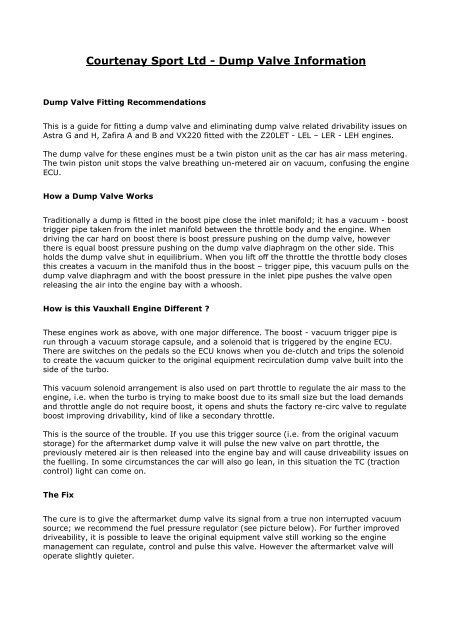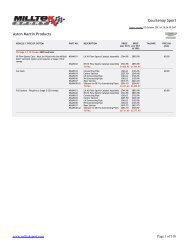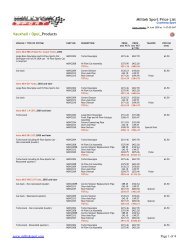Courtenay Sport Ltd - Dump Valve Information
DV Fitting Info - Courtenay Sport
DV Fitting Info - Courtenay Sport
- No tags were found...
Create successful ePaper yourself
Turn your PDF publications into a flip-book with our unique Google optimized e-Paper software.
<strong>Courtenay</strong> <strong>Sport</strong> <strong>Ltd</strong> - <strong>Dump</strong> <strong>Valve</strong> <strong>Information</strong><br />
<strong>Dump</strong> <strong>Valve</strong> Fitting Recommendations<br />
This is a guide for fitting a dump valve and eliminating dump valve related drivability issues on<br />
Astra G and H, Zafira A and B and VX220 fitted with the Z20LET - LEL – LER - LEH engines.<br />
The dump valve for these engines must be a twin piston unit as the car has air mass metering.<br />
The twin piston unit stops the valve breathing un-metered air on vacuum, confusing the engine<br />
ECU.<br />
How a <strong>Dump</strong> <strong>Valve</strong> Works<br />
Traditionally a dump is fitted in the boost pipe close the inlet manifold; it has a vacuum - boost<br />
trigger pipe taken from the inlet manifold between the throttle body and the engine. When<br />
driving the car hard on boost there is boost pressure pushing on the dump valve, however<br />
there is equal boost pressure pushing on the dump valve diaphragm on the other side. This<br />
holds the dump valve shut in equilibrium. When you lift off the throttle the throttle body closes<br />
this creates a vacuum in the manifold thus in the boost – trigger pipe, this vacuum pulls on the<br />
dump valve diaphragm and with the boost pressure in the inlet pipe pushes the valve open<br />
releasing the air into the engine bay with a whoosh.<br />
How is this Vauxhall Engine Different ?<br />
These engines work as above, with one major difference. The boost - vacuum trigger pipe is<br />
run through a vacuum storage capsule, and a solenoid that is triggered by the engine ECU.<br />
There are switches on the pedals so the ECU knows when you de-clutch and trips the solenoid<br />
to create the vacuum quicker to the original equipment recirculation dump valve built into the<br />
side of the turbo.<br />
This vacuum solenoid arrangement is also used on part throttle to regulate the air mass to the<br />
engine, i.e. when the turbo is trying to make boost due to its small size but the load demands<br />
and throttle angle do not require boost, it opens and shuts the factory re-circ valve to regulate<br />
boost improving drivability, kind of like a secondary throttle.<br />
This is the source of the trouble. If you use this trigger source (i.e. from the original vacuum<br />
storage) for the aftermarket dump valve it will pulse the new valve on part throttle, the<br />
previously metered air is then released into the engine bay and will cause driveability issues on<br />
the fuelling. In some circumstances the car will also go lean, in this situation the TC (traction<br />
control) light can come on.<br />
The Fix<br />
The cure is to give the aftermarket dump valve its signal from a true non interrupted vacuum<br />
source; we recommend the fuel pressure regulator (see picture below). For further improved<br />
driveability, it is possible to leave the original equipment valve still working so the engine<br />
management can regulate, control and pulse this valve. However the aftermarket valve will<br />
operate slightly quieter.
Fuel Pressure Regulator Location<br />
Fuel Pressure Regulator (arrowed) showing take-off point for a vacuum feed for an aftermarket<br />
dump valve.<br />
For Astra G and H: The fuel pressure regulator is located at the left hand end of the fuel rail<br />
when viewed from the front of the car. It is partially obscured by the cross-over pipe.<br />
For VX220: The fuel pressure regulator is located at the right hand end of the fuel rail when<br />
viewed from the rear of the car.
















